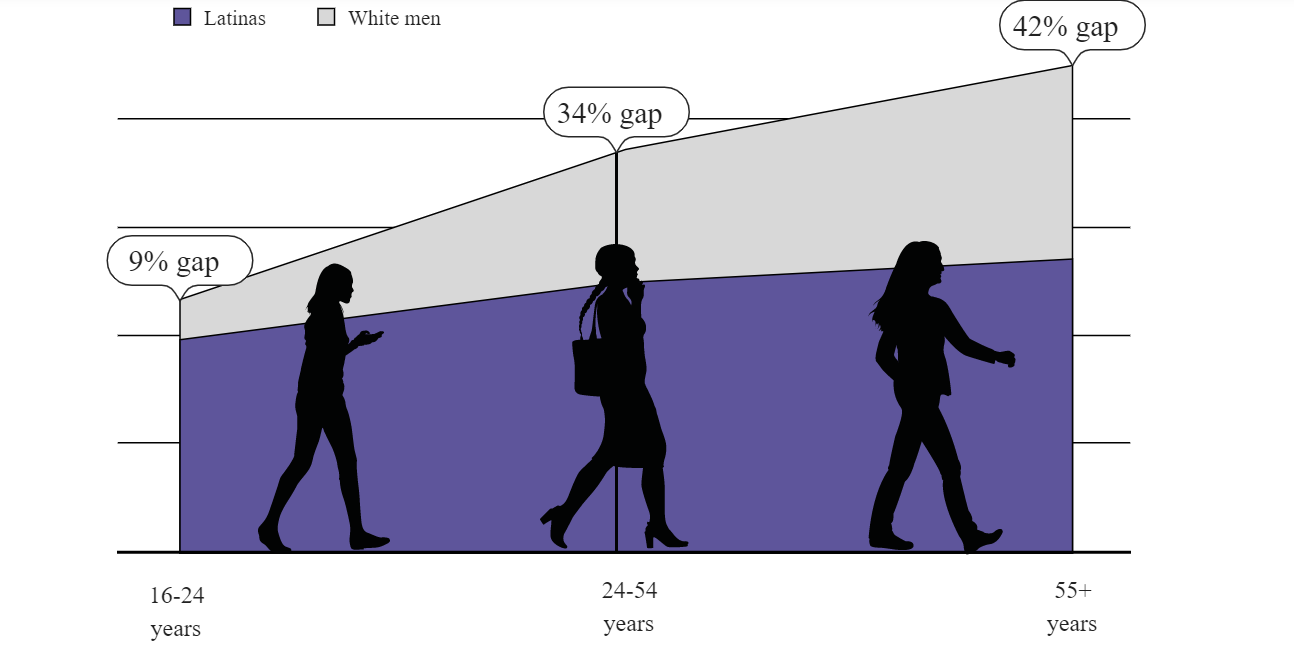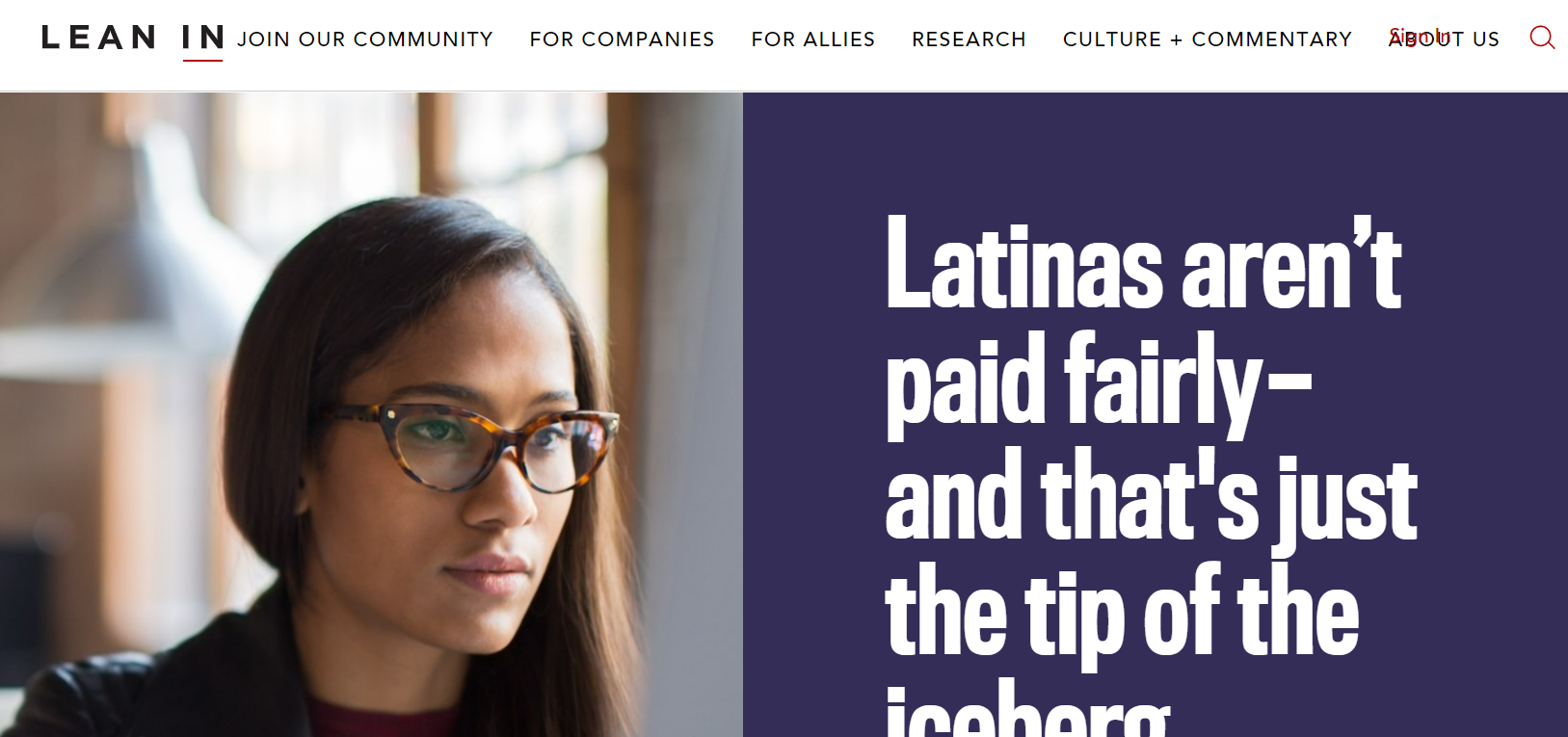WORKPLACE JUSTICE
EQUAL PAY FOR LATINAS
Latinas who work full time, year round are paid just 53 cents for every dollar paid to white, non-Hispanic men. This gap, which amounts to an annual loss of $28,386, means that to make as much as white, non-Hispanic men typically do in one 12-month calendar year, Latinas have to work 22 months— until the beginning of November in the following calendar year.
The wage gap between Latinas and white, non-Hispanic men is far larger than the wage gap between all women and all men; women overall working full time, year round in the United States are typically paid 80 cents for every dollar paid to their male counterparts. The wage gap between Latinas and white, non-Hispanic men has barely budged over the past 30 years and actually increased by one cent in 2017.
Get the facts about the pay gap for Latinas
Some Latinas experience substantially wider wage gaps than the wage gap for Latinas overall
• Latinas of Central American origin experience the highest wage gap and typically make less than half— 47.3 percent—of what white, non-Hispanic men typically make. And Mexican and Dominican women typically make barely more than half of what white, non-Hispanic men make (50.9 percent and 54.5 percent, respectively).
• Cuban (57.1 percent), South American (63.6 percent), and Puerto Rican (65.5 percent) Latinas all make less than two thirds of what white, non-Hispanic men make.
• Latinas of various origins also earn less than their Latino counterparts, although the disparity in pay is less than that between Latinas and white, non-Hispanic men
The Pay Gap
Latinas are paid less than white men and white women
On average, Latinas in the U.S. are paid 51% less than white men and 31% less than white women.
How it Works
The pay gap starts early
From age 16, Latinas are paid less than white boys the same age—and the gap only grows from there.
The Pay Gap by Age
The pay gap widens for educated Latinas
Latinas are going to college at higher rates than ever before.3 But education doesn’t eliminate the pay gap. In fact, the gap is largest for Latinas with a bachelor’s degree, who earn 31% less than white men on average.
The Pay Gap by Education Level
Even in the same job, Latinas get paid less
Many people assume that Latinas face a pay gap because they're concentrated in lower-paying roles. But even in the same job, Latinas are paid less than white men. For example, Latina nurses earn 25% less than white men nurses, on average.
The Pay Gap by Occupation
DID YOU KNOW?
Nearly 1 in 3 Americans is not aware of the pay gap between Latinas and white men.
Latinas are asking for more
Latinas ask for promotions and raises at similar rates to white men—yet the "broken rung" still holds them back at the first critical step up to manager. For every 100 men promoted to manager, only 71 Latinas are promoted.
Why it Matters
The average Latina loses out on over a million dollars
The pay gap is not about a single paycheck. Over the course of the average Latina’s career, the lost income adds up to over a million dollars compared to white men.
Average Income Lost Over a Lifetime Due to the Pay Gap
DID YOU KNOW?
The pay gap widens the wealth gap: how much Latinas are worth or own. The average Latina’s net worth is less than 1% of the average white man’s.
Families are on the front line
The pay gap is even worse for Latina mothers: They earn 54% less than white fathers. When Latinas are paid less, they have less money for basic family necessities like rent, groceries, and school supplies. Over time, this impacts families’ ability to invest in savings, higher education, or property.
The Pay Gap for Latina Mothers
DID YOU KNOW?
There is a stereotype that Latinas are domestic and not ambitious in their careers, which can make employers assume they don’t want to or expect to be paid well—despite being on average about as ambitious as white men.
Latinas face a double-edged sword of sexism and racism in the workplace: As women, Latinas are stereotyped as less competent than men, and as Latinx Americans, Latinas are stereotyped as less intelligent than white people. Researchers believe that bias is to blame for over half of the pay gap for Latinas.
Latinas deserve fair pay. It’s time to close the gap.
Resources
Sources
Ariane Hegewisch and Eve Mefferd, “Lost Jobs, Stalled Progress: The Impact of the ‘She-Cession’ on Equal Pay; The Gender Wage Gap in 2020,” IWPR #C505 (September 2021), https://iwpr.org/wp-content/uploads/2021/09/Gender-Wage-Gap-in-2020-Fact-Sheet_FINAL.pdf.
Bureau of Labor Statistics, “Weekly and hourly earnings data from the Current Population Survey” (August 2021), https://data.bls.gov/PDQWeb/le.
National Center for Education Statistics, “Indicator 19: College Participation Rates” (February 2019), https://nces.ed.gov/programs/raceindicators/indicator_REA.asp.
Bureau of Labor Statistics, “Weekly and hourly earnings data from the Current Population Survey” (August 2021), https://data.bls.gov/PDQWeb/le.
The U.S. Census Bureau, Current Population Survey, Annual Social and Economic (ASEC) Supplement: Table PINC-06: Wage and Salary Workers—People 15 Years Old and Over by Total Wage and Salary Income, Work Experience, Race, Hispanic Origin, and Sex (retrieved March 18, 2021), https://www.census.gov/data/tables/time-series/demo/income-poverty/cps-pinc/pinc-06.2019.html.
This SurveyMonkey/LeanIn.Org poll was conducted online from October 25 to 29, 2019, among a total sample of 5,690 adults age 18 and over living in the United States. The modeled error estimate for the full sample is +/- 2 percentage points, and for Latinas +/- 7 percentage points. Data have been weighted for age, race, sex, education, and geography using the Census Bureau’s American Community Survey to reflect the demographic composition of the United States age 18 and over.
LeanIn.Org and McKinsey & Company, Women in the Workplace 2020 (October 2020), https://womenintheworkplace.com/.
LeanIn.Org and McKinsey & Company, Women in the Workplace 2020 (October 2019), https://womenintheworkplace.com/.
National Women’s Law Center, “The Lifetime Wage Gap, State by State” (March 2021), https://nwlc.org/resources/the-lifetime-wage-gap-state-by-state/.
Heather McCulloch, Closing the Women’s Wealth Gap: What It Is, Why It Matters, and What Can Be Done About It (January 2017), https://womenswealthgap.org/wp-content/uploads/2017/06/Closing-the-Womens-Wealth-Gap-Report-Jan2017.pdf.
Jasmine Tucker, “The Wage Gap Has Robbed Women of Their Ability to Weather COVID-19,” National Women’s Law Center (March 2021), https://nwlc.org/wp-content/uploads/2021/03/EPD-2021-v1.pdf.
Ruta Yemane and Mariña Fernández-Reino, “Latinos in the United States and in Spain: The impact of ethnic group stereotypes on labour market outcomes,” Journal of Ethnic and Migration Studies 47, no. 6 (2021), https://www.tandfonline.com/doi/full/10.1080/1369183X.2019.1622806.
LeanIn.Org and McKinsey & Company, Women in the Workplace 2019, unpublished data.
In one study, Latinas were rated less competent and less worthy of hiring than any other racial or ethnic group of women; see https://www.insidehighered.com/news/2019/06/07/new-study-finds-discrimination-against-women-and-racial-minorities-hiring-sciences
Kate Bahn and Will McGrew, “The intersectional wage gaps faced by Latina women in the United States,” Washington Center for Equitable Growth (November 1, 2018), https://equitablegrowth.org/the-intersectional-wage-gaps-faced-by-latina-women-in-the-united-states/.

















